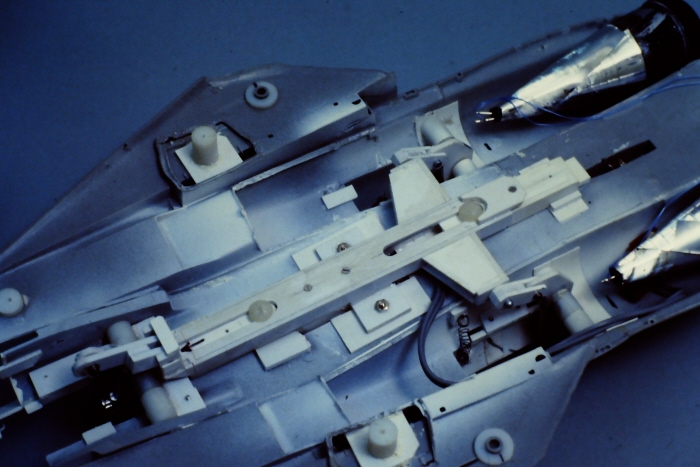
Handle fully folded, and gear fully deployed - The landing gear is extended, ready to "land".

Big Wing model--internal mechanism - This is a photo of the internal mechanism; it operated the landing gear from the position of the support handle.
Extending the gear simply pushed open the spring-loaded gear doors. The engine LED reflectors are visible to the right.

Big Wing with swing wings extended - The model is based on a modified Revell plastic model kit of the F-14 Tomcat fighter. The kit was seriously altered to make it a LOT smaller; the wings were cut down in length, as was the fuselage. I think we took almost 6 inches off the original kit's length and width.
Since the F-14 was transonic, it had this interesting variable-sweep wing for subsonic and supersonic flight regimes. It was a great way to modify the shape of the toy for a realistic reason.

Big Wing with wings folded - Pushing the button to the rear of the canopy would fold the wings slowly back for supersonic flight. This had to be done before the afterburners could be activated. Extending the gear also extended the wings.
Also--if you were "hit" too many times during combat, the canopy would open, and your figure and seat would eject! And, if the commander got too angry at you because you screwed up too much, he could eject you too. Talk about criticism...

Big Wing command headset with targeting sight stowed - The Big Wing had a command headset that allowed you to hear the sound effects and audio commands, and it also had a targeting sight, sort of like Luke's in the first Star Wars movie, but cooler. In this view, the targeting sight is folded up and stowed.
The microphone is partially functional--if your commander asked you a question, it would listen for some sort of audio response--it couldn't tell what was being said, but a response would shift the tracks and it would seem like he'd heard you.

Big Wing command headset with targeting sight extended - When the button on the earpiece on the left was pushed, the orange targeting sight would slowly lower and extend, unfolding so that it the target reticle was deployed in front of the user's right eye.
The headset was functional, with a driver in each earcup. Switch-type sensors told the logic if the sight was deployed or stored.
gLike























































